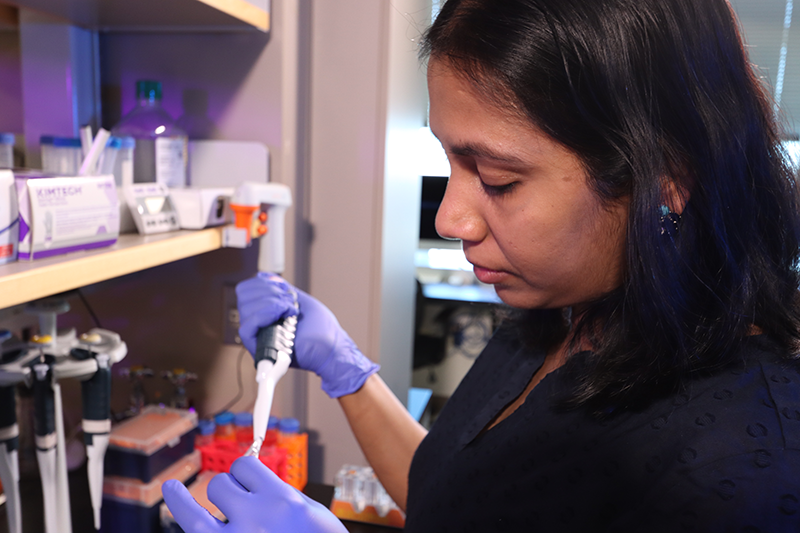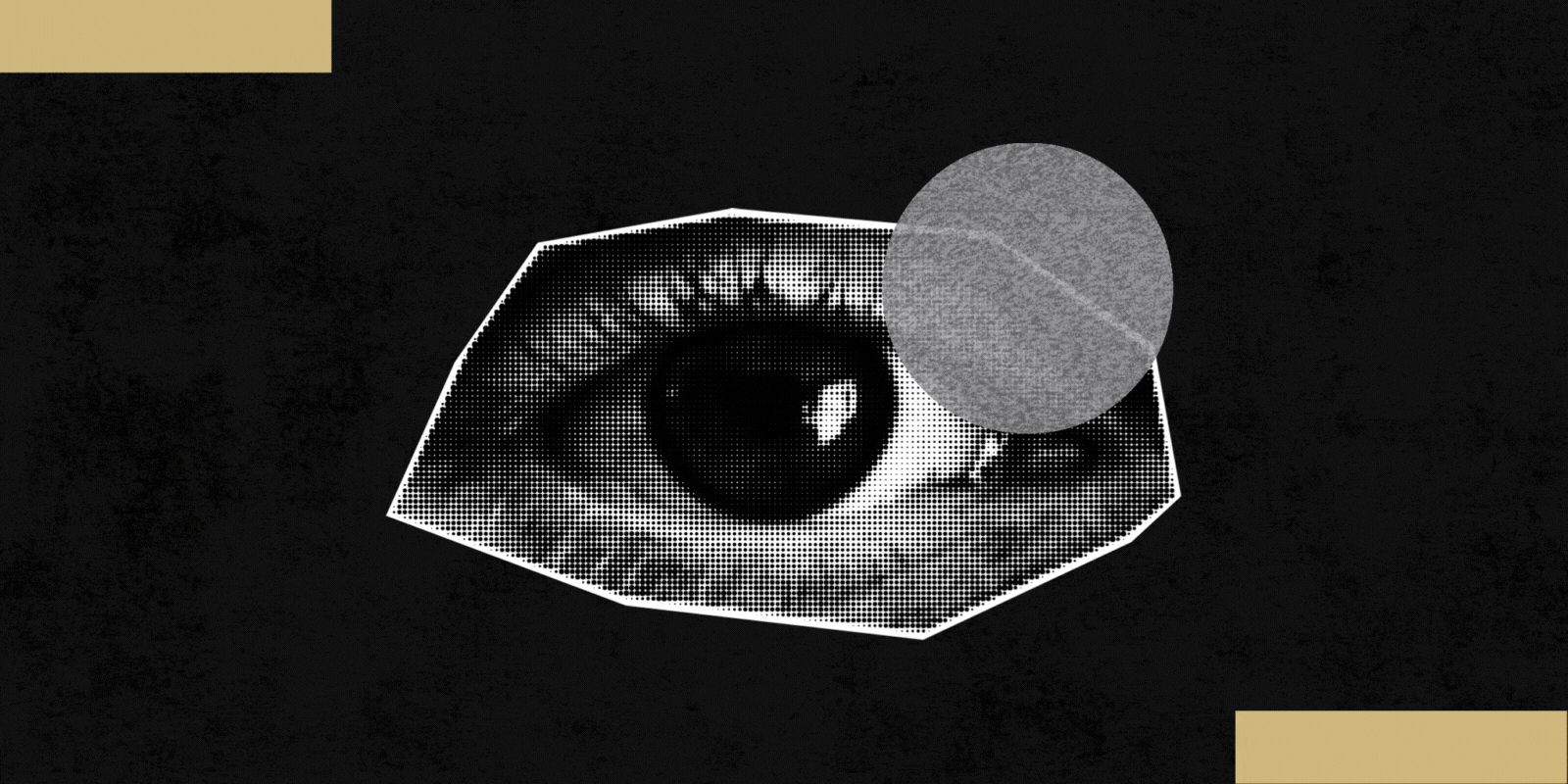Sujatha Jagannathan, PhD, chases RNA for a living and the pursuit often takes her in directions she didn’t expect to go.
It turns out that the detours are the journey’s reward.
“Anytime nature breaks things,” Jagannathan says, “you can swoop in and understand exactly how the pathway works. Why is it broken? And what happens if you break a pathway like that?”
It’s the mistakes that provide the opportunity to learn, she says.
“I study how mistakes in these molecules called RNA are handled by cells, basically,” she says. “We all have a genome in which genes are encoded. It’s sort of like this big cookbook, where you have every recipe possible. Each cell in our body makes a subset of those genes that gives them their identity.”
Messenger RNA, or mRNA, transfer information from the cookbook to other parts of the cell, where they are key ingredients to making proteins.
Detour leads to RNA research
To end up running a laboratory focused on mRNA at the University of Colorado School of Medicine, Jagannathan herself took her own detour. “I went to Duke to do my PhD in microbiology, and I came across this lab that did RNA biology and I said, ‘That sounds cool, let’s give it a shot,’” she says. “And I fell in love.”
Jagannathan had planned to study bacteria – microscopic single-celled “bugs” that can sometimes make people sick – but turned her attention to those microscopic messengers hauling the instructions for life itself.
“There’s just something about the idea of this chancy and unstable molecule orchestrator thing, you know,” she says. “How it affects everything from how humans are made, embryogenesis, all the way to diseases and aging and this whole plethora of functions, just fascinated me. And I thought, ‘Okay, studying bacteria was nice, but this is what I’m going to do.’”
Jagannathan had completed a bachelor’s degree in industrial biotechnology at Anna University in Chennai, India, in 2006 before heading to Duke University, where she earned a PhD in cell biology.
“I specifically studied how RNA molecules go to different places in the cell,” she says. “Because putting the same molecule in different parts of the cell can give it different properties, exactly the same molecule in different places has different properties. It’s really amazing.”
From Duke, Jagannathan went Fred Hutchinson Cancer Research Center in Seattle for a four-year postdoctoral fellowship.

“I knew coming off of my PhD that I wanted training in computational biology, because that’s where biology was heading,” she says. “I wanted to be able to do these high-throughput approaches, analyze my own data, really take advantage of computation as a tool to understand the intricacies of biology.”
In Seattle, Jagannathan worked on research of facioscapulohumeral muscular dystrophy (FSHD), a debilitating disease that slowly consumes skeletal muscle in the face, scapula (shoulder blade), and humerus (upper arm).
Combining her interests in RNA biology and computational biology, Jagannathan collected data measuring RNA and protein levels in cells that express the protein DUX4. That protein induces changes in hundreds of genes that affect dozens of interconnected pathways. With so many connections, specific causes of FSHD are hard to discern. Her studies helped identify patterns for more targeted research.
“Normally, this protein is expressed in early development,” she says. “But in people who have this disease, the protein turns on in this skeletal muscle, and turns on genes that should have no business being expressed in skeletal muscle.”
Such research is a step-by-methodical-step process.
“When you think of science, it’s sort of like climbing a mountain,” she says. “Every day, you’re putting your head down, and you’re just climbing. That can be hard, right? And then when you have a team of people that you’re doing it with, you are cheerleading, helping, facilitating, seeing them go up the mountain too.
“The reward is really when you can go to a height and you can see a new vista, something you didn’t know existed, something that’s going to now open up so many new opportunities. I think that’s the joy. Seeing it myself, but also helping other people see it too.”
RBI opens door for collaboration
For Jagannathan, the RNA Bioscience Initiative at the University of Colorado School of Medicine provided an opportunity to work in a community of scientists with similarly focused research.
“I came to CU because of this group,” she says. “I had other offers, but this was the place that made me feel that as an RNA person, I couldn’t be in a better place.”
Jagannathan, an assistant professor of biochemistry and molecular genetics, and other RNA Bioscience Initiative scientists are clustered in offices and laboratories on the same floor of one of the research towers on the CU Anschutz Medical Campus.
“If I just step out into the corridor, I can run into any colleague and I can ask, ‘Hey, you know, I have this idea, what do you think?’ And they can shut it down or they can say, ‘Here’s another way of thinking about it, or here’s the reagent I have, go do the experiment, or I can do the experiment for you.’ These are the opportunities of being here. It’s the community, it’s just enabled science that I did not think I would be doing four years ago.”
When the COVID pandemic disrupted operations for several months in 2020, scientists worked from home to review studies and analyze previously collected data. But getting back to the labs was a high priority. Jagannathan served on a working group to help the campus explore childcare opportunities so that working parents could return to campus sooner.
The kind of basic research conducted by the RNA Bioscience Initiative members is fundamental for future scientific advances. Jagannathan notes that vaccines for COVID-19 were developed quickly because of decades of research.
“We wouldn’t have a COVID vaccine if the basic science hadn’t been done for the past 30 years,” she says. “There are people who say, ‘Oh, this vaccine just came out of nowhere.’ No, it did not come out of nowhere. It came out of the work of basic scientists for decades. You have to have that foundation. You can’t build therapies overnight like that if you don’t have people putting in the time.”
The dedication to knowledge is necessary, but not the sole purpose of the scientific endeavor, Jagannathan says.
“It doesn’t make sense for me to say, ‘Here’s the science I want to do, here’s the person who can do that.’ It’s more than that. It’s really about who do I want to come out of the lab. What kind of scientists are we putting out into the world? Are they good citizens? Are they kind people? I want my lab to be a place that can produce really good quality scientists who go out and are a positive presence in the world.”



